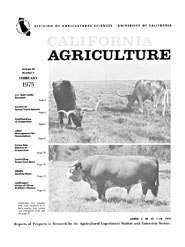


University of California
California Agriculture
|
|||
|
|||

Cover:
California's beef industry from early longhorn to today's modern beef animal (see centennial series article).
February 1975
Volume 29, Number 2 News and opinion |
|||
|
University of California, 1301 S. 46th St., Bldg. 478 Richmond, CA
|